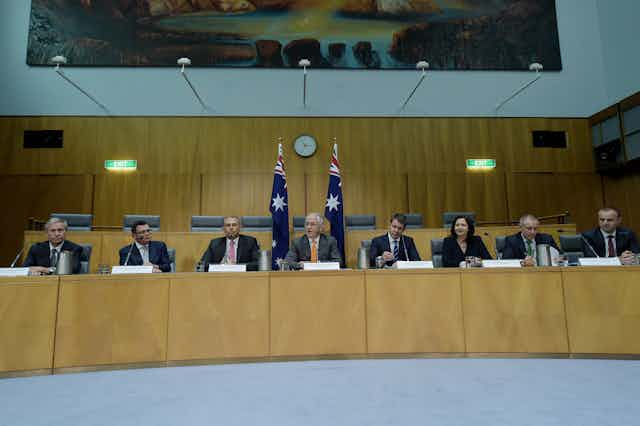The Conversation has asked 20 academics to examine the big ideas facing Australia for the 2016 federal election and beyond. The 20-piece series will examine, among others, the state of democracy, health, education, environment, equality, freedom of speech, federation and economic reform.
Prime Minister Malcolm Turnbull’s recent radical plan to return a limited income-tax power to Australia’s states – which he trumpeted as “the most fundamental reform to the federation in generations” – died as an idea within a week.
At one level, this was just another example of thought-bubble politics, policy on the run, pre-election positioning. At a deeper level, it was indicative of much of what is wrong in Australia’s federation. A dysfunctional unilateralism characterises intergovernmental relations.
What’s the problem?
Australia’s Constitution created two levels of government that were intended, in the largest part, to function independently of one another. It is therefore understandable that no mechanism was included for intergovernmental relations.
The Senate was envisaged as providing some sort of representation for the states in national decision-making. However, being popularly elected rather than appointed by the state governments, it was never going to function in that way – and never has.
This was not a real problem until the Commonwealth seized control of the main tax sources in 1942 and then went on to use its surplus revenue to expand further and further into areas of state jurisdiction.
The resulting extreme vertical fiscal imbalance (VFI) is a system where, far from operating autonomously, the two levels of government are deeply entangled. In particular, the Commonwealth tends to use its fiscal power to lay down the rules in various policy areas. Yet it still relies on the states for the actual implementation and administration of policies and programs, and the delivery of public services.
If there’s any justification for accusing the states of treating the Commonwealth like an ATM, this is it.
In response to this entanglement, the Commonwealth and the states agreed in the early 1990s to formalise their working relationship by establishing the Council of Australian Governments (COAG).
COAG, however, is only a meeting. It is perhaps not “nasty, brutish and short”, but it is certainly short, occasional and Commonwealth-dominated.
A painful lack of cohesion and co-operation among the states has greatly facilitated Commonwealth unilateralism. If the states cannot agree to a common position on fixing vertical fiscal imbalance, then there is no surprise the Commonwealth continues to provide no realistic solution.
Recognising this problem, the states came together in 2005 to create their own collegial body: the Council for the Australian Federation. For a brief moment it functioned well. However, the collective spirit soon waned and it lost momentum and relevance.
Can we learn from overseas?
Could things work better? Perhaps. The reality, though, is that intergovernmental relations are not the strong point of federal systems generally.
Germany is the most obvious exception. Its Bundesrat, or Federal Council, really is a states’ house since it is made up of emissaries from the state governments. As a consequence, the federal government must negotiate in good faith with the states since they have veto power over any federal legislation that concerns them.
This is reinforced by a principle of constitutional interpretation that requires Germany’s governments to be faithful to federalism’s principles. Not surprisingly, Germany has solved the fiscal problem besetting Australian federalism by establishing a system of joint taxation. Constitutionally defined shares of the main taxes go to the respective levels of government.
In Switzerland, intergovernmental relations also function reasonably well. This is not because of similar institutional advantages to those of Germany, but because the states co-operate and co-ordinate much better between themselves.
In some areas this means jointly solving problems in a way that obviates the need for central government intervention. In others, this means presenting a united front to the central government.
Unsurprisingly, Germany and Switzerland are the two federations where the states have taken steps to ensure strong representation in the capital. Each of the German states has its mission or representative office in Berlin. Some could be mistaken for foreign embassies.
Each of the Swiss states is represented in the national capital via the Conference of Cantonal Governments’ House of the Cantons.
No such established framework of co-operative relations exists in Canada. But its provinces tend to take a stronger position in relation to the federal government, led in particular by Quebec and Alberta.
The provinces also have a reasonably successful intergovernmental body of their own, the Council of the Federation. It greatly helps the situation in Canada that the federal government was only able to co-opt the income tax system for the duration of the second world war. It was not able to take over the tax system permanently.
Additionally, the provinces are free to levy their own sales taxes. Over the years a system of tax-base sharing has evolved to minimise administrative complexities while providing each province with substantial own-source revenues and scope to differentiate itself from others.
There is much in these overseas practices that would be of benefit to Australian federalism. Better outcomes would result from better processes. The states wouldn’t be in the position of chronic disadvantage where they are regularly scorned for refusing to accept offers that are neither advantageous nor workable, or even necessarily offered in good faith.
The prerequisite for such reforms is much more determined and effective collective action by the states.
You can read other articles in the series here.

